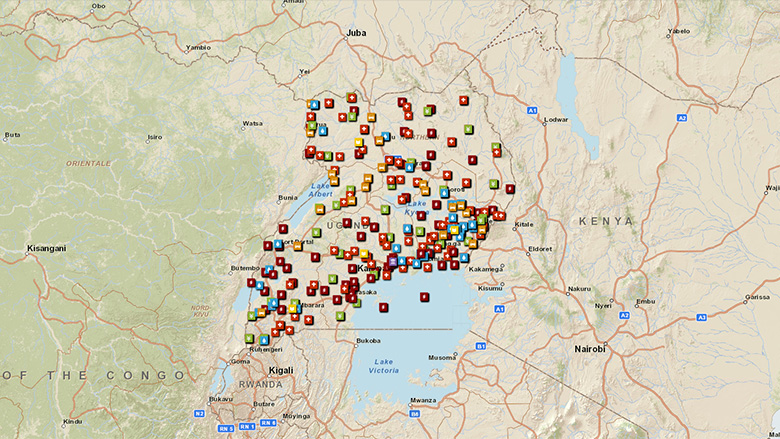Challenge
Following political stabilization in 1986, Uganda became one of Africa’s fastest growing economies, growing at 7.4% annually from 1989 to 2009, largely through agricultural exports. Since 2009, drought, along with increasing food and oil prices slowed growth, though the poverty rate shrank from 56% in 1992/93 to 24% in 2009/10. In 2011, Uganda found itself at 161 of 187 in the Human Development Index. Uganda’s northwest Karamoja region hosts over 50 different economic minerals, but the mining sector’s contribution to gross domestic product (GDP) sunk from six percent in the 1970s to less than 0.5% in 2010. Artisanal and small-scale mining (ASM) produces more than 90% of metallic, industrial and building minerals, providing livelihoods to almost 200,000 individuals. However, ASM is under regulated and hazardous, evidenced by the use of mercury in small-scale gold production. At the turn of the century, the government sought to modernize its mining industry by creating a more favorable investment climate with a streamlined bureaucracy, transparent allocation of licenses, and heightened use of geologic information.
Solution
The project leveraged World Bank experience showing that successful mining countries enacted legal, fiscal, environmental, and social policies in tandem, all of which included broad stakeholder consultation. An interdisciplinary and gender-responsive model of ASM training and extension was supported, based on building capacity and intersectoral linkages between the Department of Geologic Survey and Mines (DGSM) and other central government agencies, local governments, and communities. The project emphasized community and sectoral development through private investments in a socially and environmentally sound manner. The mineral sector’s legal, regulatory, and institutional framework was reformed and the DGSM was strengthened. Benefit sharing with mining communities was piloted by testing decentralized mining taxes and management in some communities and also by providing small grants for safer, environmentally friendlier, and more lucrative income generation practices in mining communities. The project created a Social and Environmental Unit, a computerized, Environmental Management and Information System, and a geo-information system to attract potential investors.
Results
As of project closing on December 31, 2011, there were 2,807 direct project beneficiaries, 45% of whom were female. The project also supported:
- The formation of 50 ASM associations to support production and marketing
- The training of 180 local trainers to educate about 1,000 miners (400 of whom were women) on practical mining-related topics
- The disbursement of 18 small grants to begin mainstreaming ASM into national and local economic development
- ASM licenses issued rose from 100 to 952 from 2003 to 2011, resulting in increased local royalty collection
- Transparency gains were realized in April 2009 when mining districts’ shares of mining royalties collected by the Uganda Revenue Authority had to be published in national newspapers
- ASM incomes increased from US$3 per day in 2006 to US$5-US$7 per day in 2011
- A new online geological database has been lauded for data that has helped increase exploration investments from US$5 million to US$65 million over the course of the project
Bank Group Contribution
IDA contributed US$31.2 million in total project financing. The bulk of this funding, about US$18 million, went to the project component focusing on geo-information and development.
Partners
The African Development Bank proved to be a crucial project partner, contributing US$7.62 million to the project, as well as its development expertise. The Nordic Development Fund contributed an additional US$6.23 million to the project. The Commonwealth Secretariat also covered the funding for the legal and regulatory review.
Moving Forward
The government has emphasized its commitment to develop the sector in the Karamoja region of northeastern Uganda sustainably, though it faces funding and staffing challenges. IDA is currently considering a request by Uganda’s Minister of Finance, Planning, and Development for US$20 million in IDA funding to support airborne geophysical surveys and geological mapping in Karamoja.
Beneficiaries
Dr. Mugisha Trifohn sought to improve the quality of his healthcare clinic. He received US$2,421 from the project, which he was able to use to purchase new equipment. This investment allowed him to increase his capacity and he is already experiencing an increase in his business turnover. Obonyo Emmanuel received US$1,563 from the project in order to improve his metal workshop. Thanks to the equipment this money allowed him to purchase, Mr. Obonyo was able to increase his income, and increasingly use his workshop to train local youth in metalworking.
